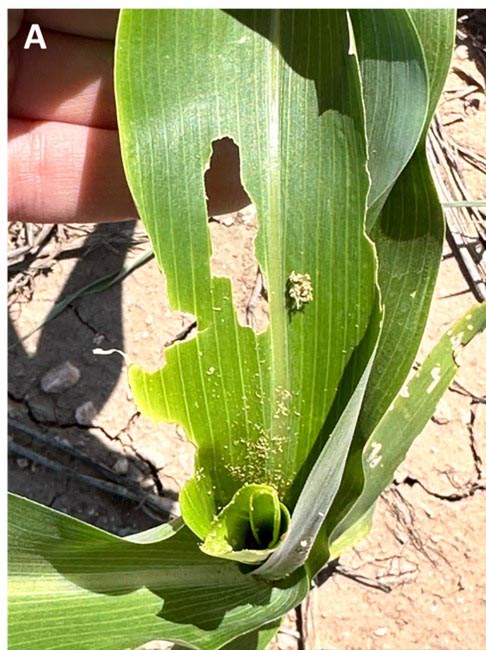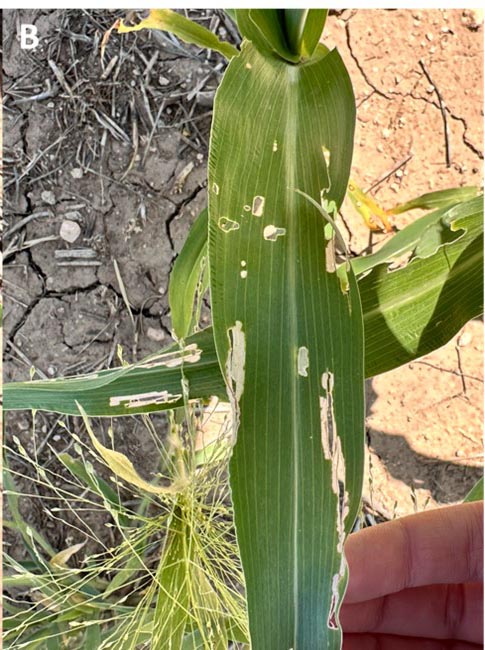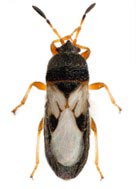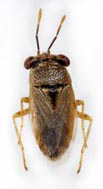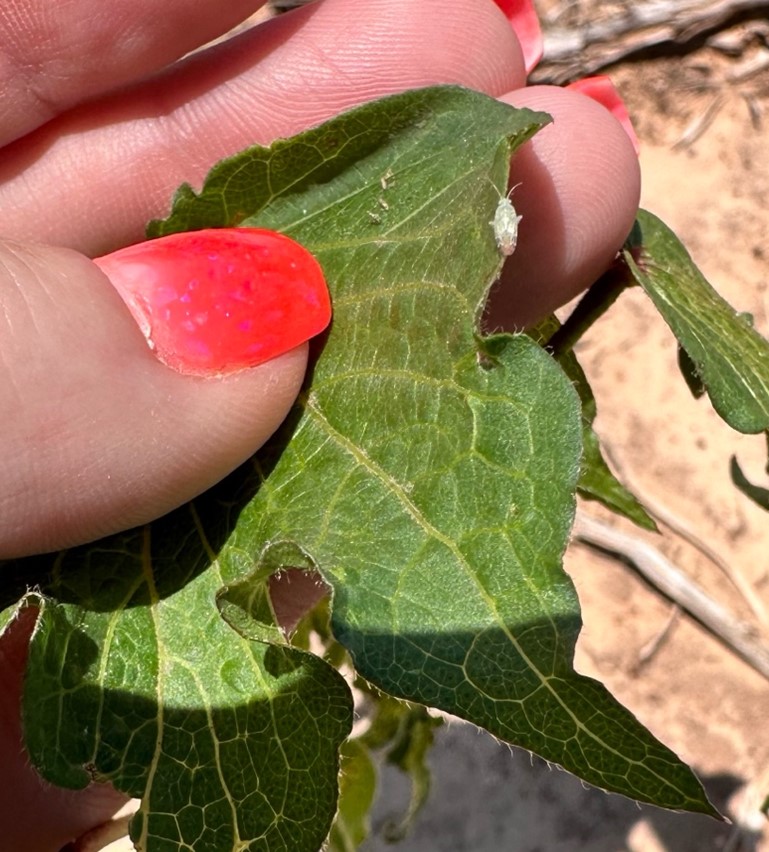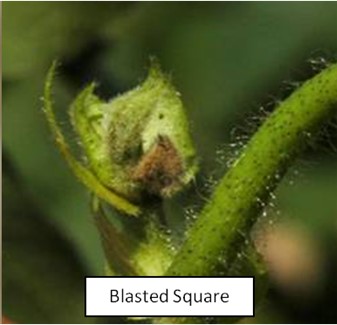Summer Insect Pest Update for Soybean, Grain Sorghum, Cotton, and Peanuts
Insect pest activity has increased over the past weeks across soybean, grain sorghum, and cotton crops. Insect pests include grasshoppers in cotton, soybean, and peanut, worms in sorghum and soybean, chinch bugs in sorghum, and fleahoppers in cotton. Producers and county educators have reported insecticide applications being used to manage these insects. Below is information regarding the pests and considerations for their management. You can receive in the field, live updates on insect pests by following osu_crop_insects on Instagram.
Grasshoppers in Field Crops
Let’s start with the insect pest we are seeing across cropping systems, grasshoppers. Many have asked why we were seeing such an increase grasshopper numbers and so early. We know that drought and heat favor grasshopper invasions while rain and cold weather slow them down. With this past fall and winter being on the mild side, female grasshoppers had plenty of opportunity to lay all their eggs over an extended period of time. I’ve heard comments about how in the past, early season rains would have activated a naturally occurring fungus that acted as a natural enemy of grasshoppers, reducing their numbers greatly. It seems that most parts of the state did not get the 3” of rain at the right time to activate this fungus. With the warmer temperatures we are now seeing populations on the rise. Like with most insect pests, it is easiest to control them when they are small.
Management
Tilling cropland in mid to late summer is one way to eliminate egg laying sites for female adult grasshoppers. Mowing alone is not enough as regrowth will be suitable environment for the grasshoppers and the eggs. Controlling summer weeds in fallow fields is important for reducing feeding sites for nymphs and egg laying sites for adult females. Early grasshopper nymphs lack wings (Figure 1) and are more susceptible to insecticide treatment than older nymphs and adults. When possible, manage grasshoppers in surrounding vegetation and pastures before they enter field crops.
Base on previous guidance from retired IPM Coordinator and Extension Cropping Systems Entomologist Dr. Tom Royer, insecticide applications in rangeland is probably never justified until numbers exceed 12 per square yard. A suggested threshold of 24 or more SMALL grasshoppers (less than ½ inches long) per square yard is a starting point for deciding whether to spray or not. The threshold for larger grasshoppers (greater than ½ inch long) is from 12-40 per square yard. Sprays are most effective if timely and practiced over large areas. For grasshopper infestations in rangeland, applying insecticides in a swathing method can save on chemical and cost while still knocking back the population. This is referred to as the Reduced Agent and Area Treatments (RAATS). To learn more about the RAAT method, see Dr. Tom Royer’s 2020 grasshopper pest alert and a recent AgriLife Extension publication from our neighbors in Texas.
In terms of grasshopper management in field crops, it is best to apply insecticide to the entire field unless infestations are only at the field borders. Cotton producers in Altus and Sentinel area have been using Orthene for grasshopper control. Vantacor, which replaced Prevathon, is also an option and has a much more concentrated, lower use rate than Prevathon. If producers still have Prevathon on hand, they can still use it. Vantacor can be alternated with Dimilin for better control of grasshoppers. If applying a pre-emergent in the early part of the season, acephate can be applied at the same time to help with grasshopper control. For these insecticide options to be effective they must be applied to the nymph stages. Always read and follow label directions for any insecticide application.
Figure 1. Early nymph grasshopper on a double crop soybean plant. (Photo: Ashleigh M. Faris, Oklahoma State University)
Soybean Larval Pests
When it comes to soybean caterpillar pests at first glance may all look the same. If you look again, you may notice that there are in fact differences in the orientation and number of their legs/feet (Figure 1). The three main caterpillars that commonly defoliate soybean are the soybean looper, the green cloverworm, and the velvetbean caterpillar, as well as others that we’ll discuss below. Once you have correctly identified the pest you can then estimate the foliar damage that they have caused and select an insecticide for control.
Figure 2. Silhouette of three common foliage-feeding soybean caterpillars: A) soybean looper, B) green cloverworm, and C) velvetbean caterpillar, corn earworm. (Image courtesy of North Carolina State University)
Soybean Looper
Description
Soybean looper larvae move just as their common name implies, in a “looping” manner. The body is green with thin, white lines running the length of the body (Figure 3). When fully grown, looper larvae are up to 1 1/4” in length. They are usually found feeding on leaves, giving the foliage a ragged appearance. They will rarely feed on pods. Soybean loopers may be confused for green cloverworms, however soybean loopers have 2 sets of prolegs on their abdomen while green cloverworms have 3 sets on their abdomen (Figure 2A & B).
Figure 3. Early instar soybean looper on a soybean leaf. (Photo: Ashleigh M. Faris, Oklahoma State University)
Life Cycle
The female moth can lay up to 600 eggs in her lifetime, which she will deposit on the undersides of soybean leaves. Egg hatch occurs in 3 days, followed by 6 larval stages over two weeks in which the larvae increase in size. Total development time from egg to adult is approximately four weeks.
Green Cloverworm
Description
Green cloverworm larvae will thrash in a violent manner when disturbed. Their body is pale green with one or more white lines running the length of the body (Figure 4). Green cloverworms have 3 sets of prolegs on their abdomen (Figure 2B). Early instars will feed throughout the soybean plant while older larvae preferentially feed in the top third of the soybean canopy. Larvae will feed on the interior of soybean leaves (Figure 5).
Figure 4. Green cloverworm feeding on soybean leaf. (Photo: Ashleigh M. Faris, Oklahoma State University)
Figure 5. Interior leaf damage on soybean caused by green cloverworm feeding. (Photo: Ashleigh M. Faris, Oklahoma State University)
Life Cycle
The female moth lays eggs on the underside of leaves and eggs hatch in 4 days. The caterpillar progresses through 6 larval instars. Once feeding is complete, they burrow into soil and crop debris to pupate. This insect can overwinter as a pupa, there are typically two generations per year.
Velvetbean Caterpillar
Description
These larvae will also move violently when disturbed. Velvetbean caterpillars can vary in color from green, to yellow, to brown, to black (Figure 6). As they grow, they will develop a white stripe along the top and two along their sides. They have five pairs of prolegs, four pairs on the abdomen and one pair at the anal end (Figure 2C) and reach about 1.9 inches at maturity.
Figure 6. Velvetbean caterpillar. (Photo courtesy Clemson University - USDA Cooperative Extension Slide Series, Bugwood.org)
Life Cycle
Female moths lay their eggs on the underside of leaves and hatch within 3 days. Larvae progress through 6 instars, then pupate. Larvae prefer to feed on upper and lower leaves, they will completely defoliate and leave only the stem. In severe infestations they will feed on the middle canopy of the soybean plant.
Corn Earworm AKA Soybean Podworm
Description
These larvae feed primarily on soybean pods. Larval color can vary from shades of pink to yellow, green, black, and brown. Corn earworm/soybean podworm larvae have darker or lighter stripes that run down the sides of the body. They are set apart from other soybean caterpillars by their short microspines between body segments (Figure 7). They have five pairs of prolegs, four pairs on the abdomen and one pair at the anal end (Figure 2C). When fully developed they can reach 1 1/5” in length. Corn earworms can also be found in grain sorghum where they feed on sorghum leaves, terminals, and heads.
Figure 7. Corn earworm/soybean podworm. (Photo courtesy John C. French Sr., Retired, Universities:Auburn, GA, Clemson and U of MO, Bugwood.org)
Life Cycle
Adult moths (Figure 8) typically lay their eggs in other crops such as corn. Soybean field infestation normally occurs in mid to late summer months, after generations have built in other cropping systems. Corn earworm larvae will overwinter as a pupa in the soil and emerge as moths in late spring, early summer.
Figure 8. Corn earworm adult moth on soybean leaf. (Photo: Ashleigh M. Faris, Oklahoma State University)
Webworms in Soybean
Description
Common webworms will infest soybean. These larvae are slender green with dark spots on the side of each body segment (Figure 9). Webworms spin a web, feed and skeletonize leaves to build a protective area for the larvae. Typically, webworm infestations will occur at field margins. This pest is generally more of a concern for late planted soybean that is stressed by heat and lack of moisture.
Figure 9. Webworm in soybean. (Photo: Ashleigh M. Faris, Oklahoma State University)
Soybean Larvae Management Guidance
To estimate soybean defoliation, randomly collect 6 leaflets (2 from the lower, 2 from the middle, and 2 from the canopy top) in 5 locations within a field. Estimate % defoliation by averaging the defoliation level from the 30 leaflets using Figure 10. Treatment thresholds are listed in Table 1.
Figure 10. Visual representation of percent defoliation in soybean. (Photo courtesy of CropWatch, University of Nebraska – Lincoln)
Table 1. Suggested treatment thresholds based on defoliation (or pod feeding) and growth stage in soybean. (Provided by Dr. Tom Royer, OSU, retired)
| Plant Stage | Treatment Threshold |
|---|---|
| 3-leaf to beginning of bloom | 35% average defoliation |
| Bloom to pod fill | 15-20% average defoliation |
| Full pod fill to maturity | 35-40% average defoliation, or 5-10% pods damaged |
In cases where there are a mix of pod feeding and defoliating caterpillars, be sure to protect the pods. The treatment threshold for corn earworm is 2 per row foot. The selection of insecticides can be made based on the predominant caterpillar species present in the field.
Due to confirmed resistance of Soybean loopers to pyrethroid, carbamate, and organophosphate insecticides, loopers can be more difficult to control than other caterpillars. Specific recommendations for control of soybean caterpillars are listed in CR-7167 Management of Insect and Mite Pests in Soybean. Always read and follow label directions.
Grain Sorghum Pests
Reports have steadily been coming in of worms in grain sorghum, as well as chinch bugs. A mix of worms have been observed causing foliar damage to sorghum in the vegetative stage. Producers are advised to be on the lookout for these worms as the sorghum enters panicle development, bloom, and grain fill. Active monitoring will give producers the best chance at timely insecticide applications if thresholds are met. Foliar damage from the worms feeding and their frass in whorls will be noticed before the worms are (Figure 11). Below are the worms that have currently been observed in grain sorghum production based on OSU scouting reports. There are numerous worms that will feed on grain sorghum throughout its development. For details on the worms not included here please refer to the OSU Fact Sheet EPP-7157 Field Key to Larvae in Sorghums.
Figure 11A. Shot hole damage from larval feeding and larval frass on sorghum leaves. (Photos: Ashleigh M. Faris, Oklahoma State University)
Figure 11B. Windowpane feeding damage from larvae feeding on sorghum leaves. (Photos: Ashleigh M. Faris, Oklahoma State University)
Corn Earworm
For details on larval identification see the description provided above in the Soybean Larvae Pests section, Figures 7 & 8.
Fall Armyworm
These larvae usually have a distinct, broad, white inverted “Y” present on the front of the head. Body varies in color from light tan to green to dark brown or nearly black in color with three widely separated narrow yellowish-white stripes down the back (Figure 12). On each side are three more broad longitudinal lines side by side; the top, brown; the middle, reddish; and the bottom, yellow with reddish mottled marks. These larvae measure up to 1 1/3” long when fully grown. Fall armyworms are primarily foliage feeders but will feed on heads.
Figure 12. Fall armyworm on grain sorghum. (Photo: anonymous Oklahoma sorghum producer)
Yellow-striped Armyworm
Yellow-striped armyworm larvae vary in color from pale gray to jet black, with two characteristic yellow stripes down the back (Figure 13). The gray individuals have two narrow dark triangles on the back of each segment, which are indistinguishable in the darker forms. The head is mostly brown. These larvae measure up to 1 1/3” in length when fully grown. They are primarily foliage feeders that will feed on soybeans as well.
Figure 13. Yellow-striped armyworm in sorghum field. (Photo: Ashleigh M. Faris, Oklahoma State University)
Sorghum Whorlworm/ Headworm Management
This year it seems the worms arrived early in sorghum with some producers asking if spraying an insecticide was worthwhile in the 5-7 leaf stage, prior to panicle development. For early infestations at the vegetative stages where worms may be in the whorl, do not initiate controls unless 40% or more of the plants in a field are infested. Because the worms are only defoliating at this point in the plant’s development, economic damage isn’t a concern and there would likely be no return for the time and money invested in spraying before panicle development. For growers in this situation, active monitoring to catch the next generation of worms as the plant progresses to the panicle development, reproductive, and grain fill stages will be critical. Worms are in the environment and spraying when the worms are in the early instar (small) stages and the panicle is developing will be critical for proper management.
OSU Extension Specialists have developed a Sorghum Headworm Quick Count Sampling Plan to aid growers in management decision making. This support tool can be found at the OSU EPP-7087 Fact Sheet Sampling for Sorghum Headworms in Oklahoma Using the Headworm Decision Support System. Scouting should begin from full panicle emergence until hard dough stage. Utilize a bucket to vigorously shake sorghum heads into and count the worms that land in the bucket. The fact sheet linked above provides step by step instructions for how to sample and sampling sheets that can be printed for use in the field to keep track of headworm counts.
For foliar insecticide applications, always read the label to ensure that the insecticide is first labeled for the crop you will be applying it to. If the label does not state that it is for use in sorghum, then do NOT use it on sorghum. For example, Bifenthrin is NOT labeled for sorghum, therefore it should not be used in sorghum. Contact your local County Extension Educator for guidance on selecting the appropriate insecticide for managing headworms.
Chinch Bugs
Chinch bug sightings have been reported in grain sorghum at various locations around the state. Damage from these insects is not being seen in early planted sorghum that is now at the advanced head stage. However, younger sorghum that was planted later in the season is seeing chinch bug infestations and damage. Double crop sorghum is already stressed due to the hot and dry conditions with chinch bugs causing even further concerns.
Description
Chinch bugs come in two forms: true and false. False chinch bugs are more widespread but seem to be easier to control and the plant can overcome their infestations. True chinch bugs on the other hand usually require a chemical control as they can cause damage to sorghum that the plant can’t overcome on its own.
True chinch bugs are larger, black bodied and have white wings (Figure 14). False chinch bugs can be distinguished from true chinch bugs by their smaller size, grayish brown coloration, and transparent wings (Figure 14). Immature chinch bugs are often reddish in color, have a white band across the back of their abdomen, and will be wingless. In Oklahoma we typically see 2-3 generations per year.
Figure 14A. True chinch bug. (Photo courtesy of NC State Extension)
Figure 14B. False chinch bug. (Photo courtesy of NC State Extension)
Chinch bugs will reside in crop residue where they are protected and can easily infest double crop sorghum. They feed at the base of the plant, in between the leaf sheath and stem. Sorghum seedlings are highly susceptible to chinch bug feeding due to their damage to roots. In larger plants, chinch bug infestations can cause stunting, lodging, and reduced yield. Infestations can be alarming, with high numbers on these insects covering the sorghum plant (Figure 15).
Figure 15. Chinch bugs on grain sorghum. (Photo: Kelly Seuhs, Oklahoma State University)
Chinch Bug Management
The threshold for chinch bugs in sorghum is 2-3 bugs per plant on seedlings. AT planting, utilizing a seed treatment such as Gaucho, Cruiser, or Poncho can allow for up to 3 weeks of protection. As the sorghum grows, treat if large numbers of chinch bugs are moving into sorghum from grain. For widespread infestations treat the entire field. As sorghum growth advances and the plant gets taller, chinch bugs can become even more difficult to control. For sorghum that is seedling to V-7 growth stage, consider banding the spray over the rows. For taller plants, ground applications using 20 to 30 gallons of water per acre and directed at the base of the plant provide the best control option. A border spray 30 to 60 feet wide on the margins of the field may be of value if chinch bug numbers are high in an adjacent wheat field. Refer to OSU Fact Sheet CR-7170 Management of Insect and Mite Pests in Sorghum for guidance on selecting an insecticide post-planting. Follow the label for application rates and be aware of the preharvest interval.
Cotton Fleahoppers
Over the last few weeks, we have had some of our first sightings and even reports of spraying for cotton fleahoppers. We are aware of a producer in Tillman county that sprayed last week for cotton fleahoppers.
Description
Cotton fleahoppers are pests in early squaring cotton and is a pest of concern for the first few weeks of squaring. They have sucking mouthparts that they use to feed on the tender, young leaves of cotton plants. As adults, cotton fleahoppers are flat and pale green with long antennae (Figure 16). Adults and nymphs feed on the sap of the cotton leaves and small squares. Feeding on squares can lead to square loss and what is referred to as blasted squares (Figure 17) which will fall off the plant. Cotton fleahopper feeding also results in abnormal cotton plant growth with shorter main-stem internodes and causing suckers to develop at the lower part of the plant. Early planted cotton can often overcome lost squares and compensate for them overtime. However, late planted or short season cotton is susceptible to lint and yield losses due to lost squares from cotton fleahopper feeding.
Figure 16. Cotton fleahopper on cotton plant. (Photo: Ashleigh M. Faris, Oklahoma State University)
Figure 17. Blasted square due to cotton fleahopper feeding. (Photo courtesy of NC State Extension)
Fleahopper Management
Weed management in and surrounding cotton fields is one way to reduce cotton fleahopper sources. Timing of weed management is critical as removing this habitat when fleahopper populations are high can result in the fleahoppers readily moving into cotton fields.
Begin scouting for fleahoppers at the 4-6 leaf stage when squares start to appear. Carefully examine the main stem terminal buds of 25 plants at four locations across the field (watch for fleahoppers that fly away when a plant is grabbed). If a field is larger than 80 acres, then more sites should be sampled within the field. It is recommended to grasp the middle of the main stem to help prevent nymphs from moving from the terminal toward the lower canopy before you have time to inspect the terminal (per TAMU AgriLife Extension). Count fleahopper adults and immatures. Scouting for fleahoppers should occur weekly. Fields should be monitored every 3-4 days in cases where conditions may lend to the rapid buildup of cotton fleahoppers in alternate hosts.
Currently no threshold exists specifically for Oklahoma cotton production and the threshold for the Texas Rolling Plains is suggested. Threshold is based on an estimate of the percent square set for the field, which is calculated from the number of fleahoppers counted and how many squares the plants retain. Refer to the Rolling Plains threshold in Table 2 (below). Suggested insecticides for fleahopper control are acephate, Bidrin, Transform, Sivanto Prime, Carbine, and Centric. Active monitoring and following economic thresholds (ETs) will allow you to make the best pest management decisions.
Table 2. Cotton Fleahopper Action Threshold. (Table courtesy of S.S. Vyavhare and D. Kerns, Texas A&M AgriLife Extension)
| Region | Fleahoppers | Cotton growth stage |
|---|---|---|
| Blacklands | 10-15 per 100 terminals | During the first 3 weeks of squaring |
| Coastal Blend Winter Garden Lower Rio Grande Valley |
15-25 per 100 terminals | During the first 3 weeks of squaring |
| Panhandle South Plains Permian Basin Rolling Plains Trans Pecos |
25-30 per 100 terminals with: | Week of squarring and Square Set 1st week <90% 2nd week < 85% 3rd week <75% After 1st bloom, treatment is rarely justified. |
References:
Kerns, D., S. Vyavhare, J. Santiago-González, and P. Porter. 2024. ENTO-PU-015. Grasshoppers and Their Control. Texas A&M AgriLife Extension. Accessed: July 2, 2024.
Jardine, D.J. 2020. Soybean Pests: Soybean Looper. Soybean Research and Information Network. Accessed: July 2, 2024.
UNL. n.d. Burrower Bugs in Soybeans. CROPWATCH. University of Nebraska-Lincoln. Accessed: July 2, 2024.
Mulder, P.G., R. Grantham, and D.C. Arnold. 2017. EPP-1756: Field Key to Larvae in Soybeans. Oklahoma State University Extension.
Royer, T., R. Grantham, and D.C. Arnold. 2017. EPP-1757: Field Key to Larvae in Sorghums. Oklahoma State University Extension.
Sorghum Checkoff. n.d. Headworms. Accessed: July 2, 2024.
Vyavhare, S.S. and D. Kerns. 2017. ENTO-073: Cotton Fleahoppers. Texas A&M AgriLife Extension. Accessed: July 2, 2024.











